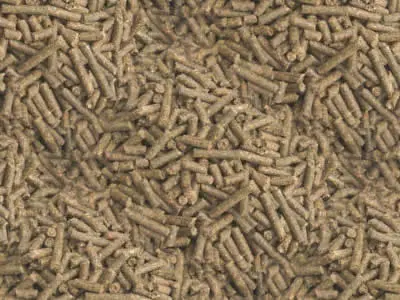Pellets and Dry Food Mix
Guinea pigs require a good quality dried food as part of their daily diet. When supplemented with plenty of fresh vegetables, hay, and water, they will be getting all the calories, vitamins and nutrients they need. Specially-formulated guinea pig pellets are the best form of dry food, but you can also buy various types of food mix which are also very nutritionally balanced.
Pellets
These are based on either Alfalfa or Timothy hay, which is ground up and mixed with various other ingredients and supplements, before being formed into easily-digestible pellets. You need to be careful that you buy pellets which are suitable for your cavies. Alfalfa hay is high in calcium, making it perfect for young (under 12 months) and pregnant pigs. However, this high calcium content can cause bladder stones in adults, and so they need to be fed a Timothy-based pellet.
Pellet food might look bland, but it contains all the nutrients your pets need.
Dry Food Mix
You can choose from a range of different food mixes, which are made from various different dried vegetables. Although these look more colourful and appealing than pellets, they allow your pets to pick and choose the bits that they like, and leave the rest. This means that they won't get such a well-balanced diet as they will from pellets.
Food mixes look more appetising than pellets, but can sometimes leave your guinea pigs lacking in certain nutrients if they don't eat it all.
Also, some mixes contain nuts and seeds, which are unsuitable for guinea pigs as they can get stuck in between their teeth and cut the roof of their mouth.
Vitamin C
Guinea pigs cannot produce their own vitamin C, and need to get it from their diet; as a result, many foods have added vitamin C. This is great, but you should not rely on it as your animals' only source of vitamins. Instead, you need to make sure their diet contains plenty of fresh vegetables, and the occasional piece of fruit. Vitamin C degrades quickly in the presence of sunlight, so be sure to store these foods in a cool, dark, dry place such as a pantry or cupboard.
Where to Buy
You can put guinea pig pellets and dry food mixes in most pet stores, and these do the job perfectly. Be sure to buy pre-packaged foods as these are fresher and more nutritious than the mixes you tend to find loose in large tubs. Respected brand names include Oxbox, Wagg, Gerty, and Burgess Excel.
Food Bowls
You will need a bowl to put your guinea pigs' food in. Look for a heavy ceramic one, as these are much less likely to get be tipped over by hungry cavies. You should wash and dry the bowl thoroughly each day when replacing the food.
A heavy ceramic food bowl is easy to clean, and won't tip over.
It can be tempting to choose a bowl which looks nice, but remember that the best bowl is the one that your pets can use easily. As such, try to find one that has quite low sides, as higher rims can be difficult to reach over, particularly for young guinea pigs.
Feeding Time
It is best to spread out your pets' feeding rather than giving them all of their food at once. Doing this can encourage them to binge, and may also result in certain foods being left in favour of others that they prefer. A good way to prevent this is to give your guinea pigs their dry food and fresh food at different times of the day. For example, you might give them pellets in the morning and vegetables in the evening.
Quantity
Between half and one handful of dry food per pig per day is considered about right, but each cavy will have different needs. Use this as a starting point and then adjust the amounts to suit your pets. If you find that they are eating it all up, add a little extra. If there is a lot of food left, give them a bit less. Obviously young guinea pigs require less food, but their needs will grow as they do.
You should also track your guinea pigs' weight to make sure they are not gaining or losing it too quickly. If they start to get fat, try giving them a bit less dry food, and make up for it with more fresh vegetables and hay.
Foods Meant for Other Animals
Many stores stock food which says it is suitable for more than one type of animal, such as guinea pigs and rabbits. You should avoid these foods as the claims simply aren't true - different animals have different nutritional requirements, and so need their food to be formulated differently. For example, guinea pigs require more vitamin C than rabbits, and feeding them rabbit food could result in a deficiency.
Making Your Own
It is possible to make your own guinea pig food by mixing bran, barley, crushed cooked peas, flakes of maize, oats, grass pellets, crushed lotus beans, and linseed oil. However, this mixture won't contain any vitamin C supplements, and it can often be cheaper and easier to buy food from a store, so think careful about whether you really want to do this.
Introducing New Food
Guinea pigs can take time to adapt to changes in their diet, so be sure to make them gradually. If you are introducing guinea pig pellets for the first time, do so by giving them a few pellets alongside their normal diet. Slowly increase the amount of pellets and decrease the amount of their other food until they have been successfully weaned onto their new diet.

